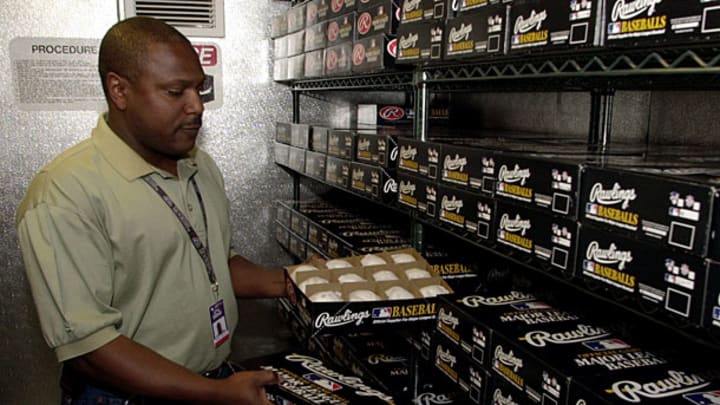Get ready for the first humidor outside Colorado

Baseballs have been stored in a humidor at Coors Field since 2002. (AP)

Baseball at high altitude is a very different sport. When the Rockies joined the major leagues as an expansion team in 1993, their ballgames — first at Mile High Stadium, and beginning in 1995, at Coors Field, which is 5,183 feet above sea level — introduced persistently high scoring levels unseen in the modern game. Thanks to the thinner, drier air, curveballs broke less, and fly balls carried farther, producing football-like scores that stood out even in a time of rising offense.
In 2002, in an effort to combat the effects of the altitude, the Rockies began storing shipments of baseballs in a humidor, with the blessing of Major League Baseball. That enabled them to control the moisture content of the balls, deadening them so that they wouldn't carry as far under such extreme conditions. Since then, scoring has fallen at a faster rate than the rest of the majors, and last year the Rockies' Triple-A affiliate in Colorado Springs — where the team plays at an even higher altitude of 6,010 feet — implemented a humidor of their own.
Now the first team outside of Colorado is about to put a humidor into play. This one belongs to the Albuquerque Isotopes, the Triple-A affiliate of the Dodgers, and one of Colorado Springs' Pacific Coast League rivals. The 'Topes play at an elevation of around 5,300 feet. As in Colorado, the move is an effort to level the playing field, not only reducing scoring levels but making it easier for the team to evaluate their hitters and pitchers, which could lead to a more productive farm system. From the linked Santa Fe New Mexican article:
Tired of bloated offensive stats that overinflate a hitter’s worth while simultaneously diminishing that of a pitcher, the Dodgers brass purchased a humidor and installed it inside the cinderblocked hallway leading from the field to the visitor’s clubhouse in Isotopes Park.
Unlike the roiling conditions outside, the humidor is set at a constant 72 degrees with a humidity level locked at 50 percent. Following strict Major League Baseball guidelines, balls must spend a minimum of two weeks in a humidor before it is used in a game. Isotopes general manager John Traub said the team usually uses between 90 and 120 balls per game. Over the course of the 72-game home schedule that equates to as many as 8,640 balls per season.
With the exception of an eight-year period from 2001 through 2008, Albuquerque has been home to the Dodgers' Triple-A affiliate since 1963. While the big club has produced more than its share of good players in that span, including 10 NL Rookies of the Year, gauging the abilities of their prospects who passed through Albuquerque via the stats produced in the inflated scoring environment — not to mention the underlying performances — has proven a challenge both for the organization and for interested observers.
As a young Dodgers fan, I salivated over outfielder Mike Marshall's PCL Triple Crown win in 1981 (.373 with 34 homers and 137 RBIs, not to mention a .445 on-base percentage and a .675 slugging percentage). Despite those gaudy stats, he went on to hit a fairly ordinary .271/.325/.449 in parts of nine seasons with the Dodgers, making just one All-Star team and falling far short of the superstardom many envisioned.
Numerous other Albu-turkeys — that's my dad's term — have failed to live up to similarly gaudy stats. From my own youth, mashers like Greg Brock, Franklin Stubbs and Sid Bream couldn't even match Marshall. More recently, the team has taken to steering many of its top prospects clear of both Albuquerque and Las Vegas, their home during that eight-year absence and another high-scoring, high-altitude PCL venue (2,200 feet, higher than every MLB venue except Colorado). Matt Kemp (83 games), Russell Martin (23 games) and Chad Billginsley (13 games) saw limited action in Las Vegas, while Clayton Kershaw never stopped there. Kenley Jansen skipped Albuquerque, as did Nathan Eovaldi (now with the Marlins) and Javy Guera made only three appearances there on a rehab assignment last year.
How much does a humidor help? Looking at the impact on Rockies' scoring, quite a bit. Since its implementation in 2002, scoring levels of games in Denver have fallen at a faster rate than the MLB average:
Years COL R/G MLB R/G Dif
1993-2001 13.6 9.8 +39%
2002-2012 11.2 9.2 +22%
Looked at another way, scoring at games played in Denver fell by 17 percent at a time when MLB-wide scoring fell by six percent. As for Colorado Springs, according to Baseball America, scoring there fell from 15.8 runs per game in 2011 to 11.6 in 2012, a drop of 26 percent.
Vernon Wells
Baseball America Prospect Handbook
